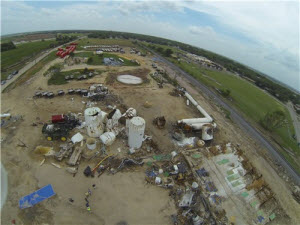A year after a massive explosion at a fertilizer storage and distribution facility in West, Texas, fatally injured 14 people and caused hundreds of injuries, the Chemical Safety Board (CSB) has released preliminary findings and recommendations relating to the cause of the explosion and the steps necessary to prevent similar incidents.

Image credit: Chemical Safety Board
According to CSB Chairperson Rafael Moure-Eraso, “The fire and explosion at West Fertilizer was preventable. It should never have occurred. It resulted from the failure of a company to take the necessary steps to avert a preventable fire and explosion and from the inability of federal, state, and local regulatory agencies to identify a serious hazard and correct it.”
At issue in the investigation are policies and practices related to the storage and handling of ammonium nitrate (AN), the fertilizer that exploded in the April 2013 incident. The CSB expressed concern that 1,351 facilities across the country store AN, many of which may be located near populated areas.
In addition, according to the CSB, lessons learned during emergency responses to AN incidents have not been effectively disseminated to firefighters and emergency responders in other communities where AN is stored and used. In the West, Texas, incident, volunteer firefighters were not aware of the explosion hazard from the AN stored at West Fertilizer, and 12 first responders perished. The CSB called for reviewing guidance from the National Fire Protection Association (NFPA), Department of Transportation (DOT), and other agencies to develop consistent recommendations for emergency response procedures where AN is involved.
The CSB urged government agencies at all levels across the country to take action in identifying hazards and requiring the safe storage and handling of AN, noting that many other countries have developed more stringent standards than the United States. OSHA does regulate the storage of ammonium nitrate at 29 CFR 1910.109(i), but the chemical is not currently included on the agency’s list of substances covered under its standard for process safety management of highly hazardous chemicals.
In August 2013, OSHA, the U.S. Environmental Protection Agency (EPA), and the Bureau of Alcohol, Tobacco, Firearms and Explosives (ATF) issued a guidance document titled “Chemical Advisory: Safe Storage, Handling, and Management of Ammonium Nitrate.” Among the recommendations contained in that document are the following:
- Avoid heating AN in a confined space, and avoid locating it near sources of heat such as steam pipes, radiators, hot ducts, light bulbs, etc.
- Avoid contamination of AN with combustible materials or organic substances such as packing materials, dust, seed, oils, and waxes.
- Also avoid contamination of AN with inorganic materials that may contribute to its sensitivity to explosion, including chlorides and some metals, such as aluminum powder, chromium, copper, cobalt, and nickel.
- Store AN only in one-story buildings and buildings with no basements, unless the basement is open on one side.
- Do not place AN into storage when its temperature exceeds 130 degrees Fahrenheit.
- AN storage areas should be equipped with an automatic sprinkler system or have an automatic fire detection and alarm system if the areas are not continuously occupied.
- Piles or bins for storing AN must be adequately sized, arranged, and moved periodically to minimize caking.